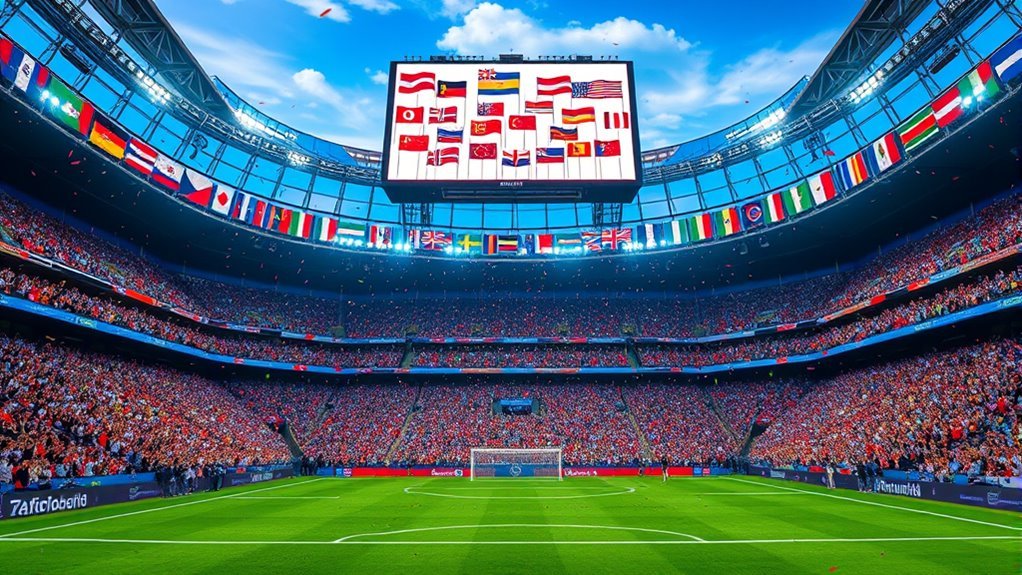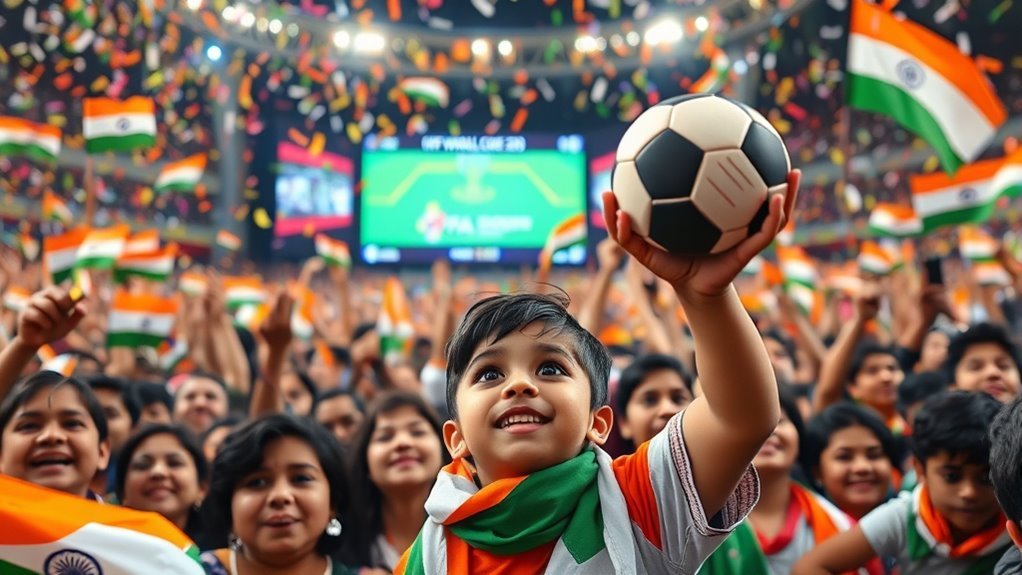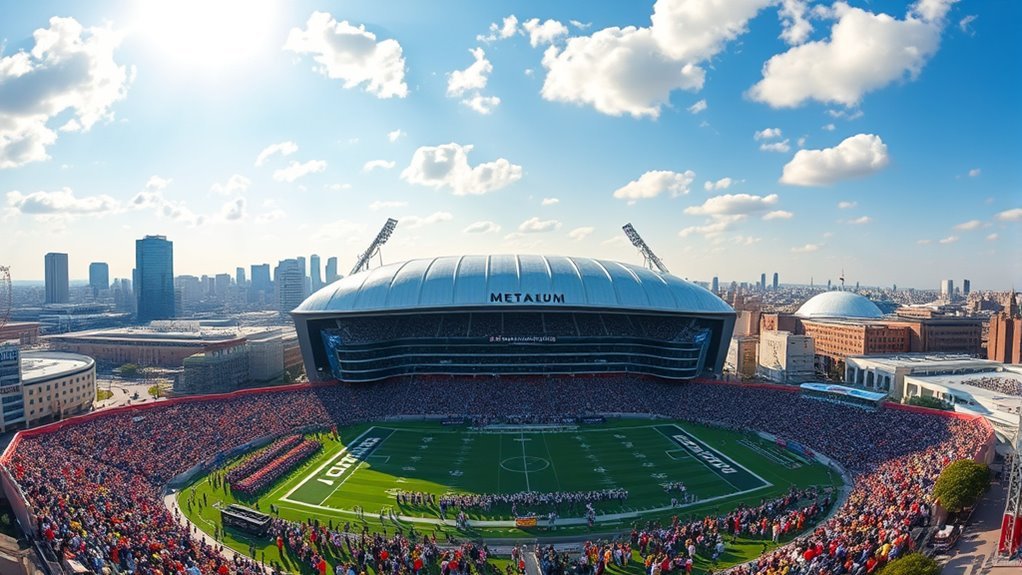The 2026 FIFA World Cup will feature an expanded format with 48 teams participating, making it the largest tournament ever. This change allows for greater representation and opportunities for underdog nations to showcase their talent. You’ll see matches structured in a new way, with increased excitement and unpredictability. Plus, the expansion could lead to unique fan experiences and cultural exchanges. Keep going to discover more about how this tournament will unfold and what it means for global football!
Overview of the Expanded Format
As the 2026 FIFA World Cup approaches, you’ll notice a significant change in its format, which expands the tournament from 32 to 48 teams. This expanded format opens the door for more nations to compete, granting a broader representation and celebrating diverse football cultures. It’s an exciting opportunity for underdog teams to showcase their talent on a global stage, creating a thrilling atmosphere that fans crave.
The tournament benefits from this change as it promises more matches and greater unpredictability, injecting fresh energy into the competition. With more teams, you’ll witness exhilarating surprises, close encounters, and unforgettable moments that make football the beautiful game. The expanded format not only enriches the experience for fans but also fosters a sense of unity among nations, reminding us of the freedom and joy that sport can inspire. Get ready for a World Cup like no other, where every kick and goal counts!
Historical Context of World Cup Participation
The expanded format of the 2026 FIFA World Cup not only marks a new era in tournament structure but also highlights the rich history of participation among nations. As you explore the world cup evolution, you’ll see how the competition has grown from its humble beginnings in 1930. Initially featuring just 13 teams, the tournament has undergone significant changes, reflecting the increasing global passion for football.
Historical participation showcases how countries from every corner of the globe have sought to compete on this grand stage. Over the decades, nations have united through a shared love for the game, pushing the boundaries of their capabilities. This evolution emphasizes not just the sport itself but the connections formed among diverse cultures. As you anticipate the 2026 event, consider the journey each nation has taken to reach this moment, embodying the spirit of freedom that football inspires worldwide.
Breakdown of the 48 Teams
With the expansion to 48 teams, the 2026 FIFA World Cup promises to be more inclusive than ever, allowing a broader range of nations to showcase their talent on the world stage. This change in team selection means more opportunities for underrepresented regions to shine. You’ll see a diverse lineup, reflecting the spirit of freedom and competition that the tournament embodies.
The tournament logistics will also evolve, accommodating this larger pool of teams. The structure will likely feature 16 groups of three teams each, ensuring every match counts towards the knockout stage. This format enhances excitement, as every goal can make a difference in a team’s journey.
Fans can look forward to thrilling matchups and unexpected surprises as nations compete fiercely for glory. The 2026 World Cup isn’t just about football; it’s about uniting cultures and celebrating the beautiful game on a grand scale.
Qualification Process for the 2026 World Cup
Expanding the tournament to 48 teams means a more intricate qualification process for the 2026 World Cup. You’ll need to keep an eye on the qualification criteria set by FIFA, as teams will compete for their spots through various regional tournaments. Here’s a glimpse of what to expect:
- Regional Representation: Each confederation will have its own allocation of slots, ensuring diverse competition.
- Match Formats: Expect different qualifying formats—some may use round-robin, while others might lean towards knockout stages.
- Performance Metrics: Teams will be judged on their past performances, ranking, and consistency.
- Playoff Opportunities: For some regions, a playoff system might be in place, giving underdog teams a chance to shine.
This process opens up thrilling possibilities, making every match count as teams endeavor for that coveted World Cup spot. Get ready for the excitement!
Regional Allocations of Spots
As you explore the regional allocations for the 2026 World Cup, you’ll notice a significant shift in how spots are divided among the confederations. This tournament will expand to 48 teams, and the new allocation criteria aim to enhance regional representation. North America, hosting the event, will receive a generous share of spots, reflecting its growing football culture.
Meanwhile, UEFA retains a substantial number, showcasing Europe’s football dominance. Other confederations, like CONMEBOL and AFC, will gain more opportunities, promoting diversity and freedom in global football.
These changes not only emphasize equitable access for teams but also encourage nations to foster their football programs. By embracing this new structure, FIFA hopes to create a more inclusive and competitive environment. It’s all about making sure every continent has a voice on this grand stage, allowing fans worldwide to celebrate their teams and cultures.
Impact on Smaller Nations
The 2026 World Cup offers smaller nations a better shot at qualification, which could change the landscape of international soccer. This increase in opportunities can spark economic growth, as hosting and participating in such events often boosts local economies. You’ll see how these changes can benefit not just teams, but entire nations.
Increased Qualification Opportunities
With 48 teams set to compete in the FIFA World Cup 2026, smaller nations are poised for unprecedented opportunities to showcase their talent on the world stage. This expanded representation means increased diversity, allowing nations that once struggled to qualify to now shine. Imagine:
- A tiny island nation scoring against a football giant.
- Local heroes inspiring the next generation with their passion.
- Unique playing styles enriching the global game.
- Cultural celebrations where every fan feels included.
These opportunities not only empower players but also unite communities, fostering a spirit of freedom and pride. The world will witness the beautiful game in ways never seen before, and that’s something to celebrate!
Economic Growth Potential
While many might focus on the excitement of the matches, the economic growth potential for smaller nations participating in the FIFA World Cup 2026 is equally significant. For these nations, the tournament isn’t just about soccer; it’s a chance to showcase their culture and attract global attention. The economic impact could be transformative, creating growth opportunities in tourism, hospitality, and local businesses. As fans flock to support their teams, smaller economies can experience a boost that fosters innovation and entrepreneurship. This exposure can lead to long-term benefits, helping to elevate their status on the world stage. Ultimately, the World Cup can be a catalyst for positive change, allowing these nations to thrive and embrace their freedom.
Changes in Tournament Structure
As FIFA prepares for the 2026 World Cup, fans can expect significant changes in the tournament structure that aim to enhance competition and inclusivity. With tournament innovations and format adjustments on the horizon, here’s what you can look forward to:
- Expanded Teams: The tournament will feature 48 teams, allowing more nations to showcase their talent.
- New Format: A three-group stage format will replace the traditional knockout rounds, giving teams more chances to compete.
- Diverse Venues: Matches will be hosted across multiple North American cities, creating a vibrant atmosphere for fans.
- Increased Matches: More games mean more excitement, with teams battling for every point in their quest for glory.
These changes are designed to make the World Cup more thrilling, giving every team a fair shot while celebrating the beautiful game on a grand stage.
Implications for Team Performance
The expanded format of the 2026 World Cup is likely to have profound implications for team performance. With an increase in participating teams, you’ll see a shift in team dynamics and strategies. More teams mean a broader range of playing styles, which could challenge traditional powerhouses to adapt quickly. You’ll have to embrace flexibility and innovation to keep pace with diverse opponents.
As the competitive balance adjusts, underdog teams can seize opportunities to upset favorites, adding excitement and unpredictability. This change encourages all teams to sharpen their skills and rethink their approaches, which can lead to more thrilling matches. For players and coaches, it’s essential to foster strong team cohesion and effective communication. Those who can harness their collective strengths will thrive in this new landscape. Consistent preparation is also key, as teams that focus on practice and strategy will be better equipped to face their rivals. So, prepare for an exhilarating World Cup where every match could redefine the balance of power on the global stage.
Fan Engagement and Experience
How will the expansion of the 2026 World Cup enhance fan engagement and experience? With more teams in the tournament, the opportunities for fan interaction and a richer spectator experience will multiply. You’ll feel the energy of diverse cultures and passionate supporters, bringing a unique vibe to every match. Imagine:
- Interactive fan zones with games, live music, and food from around the world.
- Virtual reality experiences that let you step into the shoes of your favorite players.
- Mobile apps offering real-time updates, exclusive content, and direct engagement with teams.
- Meet-and-greet events with players, creating unforgettable memories.
This isn’t just about watching soccer; it’s about feeling every moment and being part of a global celebration. With these enhancements, the 2026 World Cup promises to be an exhilarating journey for every fan, making you feel more connected than ever.
Future of the FIFA World Cup Beyond 2026
With the excitement surrounding the 2026 World Cup, it’s natural to wonder what lies ahead for this iconic tournament. As you look to the future, expect a stronger emphasis on sustainability initiatives. FIFA’s commitment to reducing its carbon footprint could lead to greener stadiums and eco-friendly practices, making the tournament more responsible and enjoyable.
Technology advancements will also play a vital role. Imagine immersive experiences powered by virtual reality, enhancing fan engagement like never before. You’ll likely see the integration of AI-driven analytics for better game strategies and real-time data that elevates the viewing experience.
As the World Cup evolves, it’ll embrace the spirit of freedom and innovation. While preserving the tournament’s rich history, the future promises an exciting blend of tradition and modernity, ensuring that every fan’s experience is unforgettable. Keep an eye on how these changes shape the beautiful game!
Frequently Asked Questions
When Will the FIFA World Cup 2026 Take Place?
The FIFA World Cup 2026 will take place from June to July. As you gear up for the tournament schedule, you’ll want to focus on match preparation to fully enjoy the excitement of this global event.
Where Will the Matches for the 2026 World Cup Be Held?
The matches for the 2026 World Cup will be held across various cities in the U.S., Canada, and Mexico, featuring stadiums with impressive capacities. You’ll experience thrilling games in iconic locations, celebrating freedom through sports!
How Will the Tournament Format Change From Previous World Cups?
Like a grand symphony, the tournament structure’s evolving. You’ll see an expanded team allocation, increasing from 32 to 48 teams, enhancing competition and allowing more nations to showcase their talent on the world stage.
Who Are the Host Countries for the 2026 World Cup?
The 2026 World Cup will be hosted by the United States, Canada, and Mexico. Each city holds cultural significance, showcasing diverse traditions and passions, allowing you to experience the vibrant spirit of soccer across North America.
What Is the Expected Impact on Ticket Prices for the Event?
Ticket prices are likely to rise due to high demand. Pricing strategies may vary, but expect a surge as fans clamor for access. You’ll want to plan ahead to secure your spot at the event.




